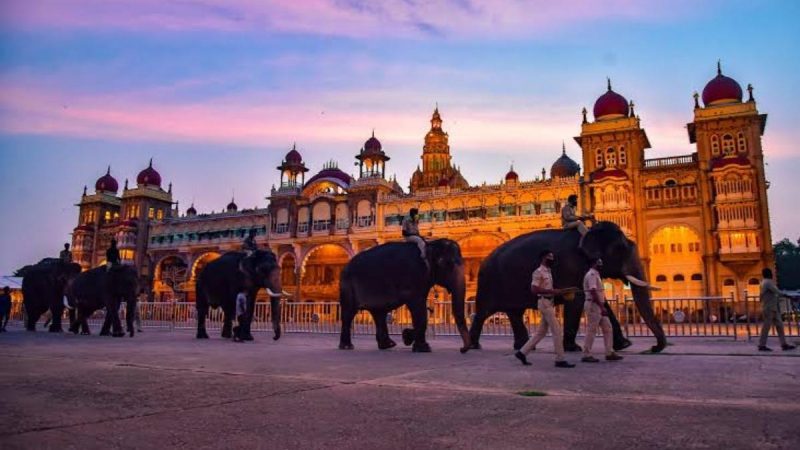Mysuru Dasara doesn’t tiptoe into town; it crashes in like a kaleidoscope of colour, sound, scent, and devotion, with every corner of the city trembling under its arrival. For ten days, Mysuru transforms into a living mural, where centuries of history brush against the present, and every street pulses with echoes from 1610, when the Wadiyars first staged this festival to celebrate Goddess Chamundeshwari’s victory over Mahishasura. That story still hums through palace courtyards, marketplaces, and winding lanes, as palpable as the fragrance of jasmine in the air.
Elephants Of Mysuru Dasara: Living Symbols Of Power and Devotion
According to News18, this year, nine elephants made their entrance like royal emissaries, trunks swaying, garlands bouncing, each step striking the ground with a reverberation you feel in your chest. The ceremonial guard of honour met them too.
At the front, the lead elephant bore the golden howdah, a 750-kilogram throne of gleaming gold cradling the Goddess herself. Each pace from Mysuru Palace to Bannimantap Grounds carried more than physical weight; it bore centuries of devotion, authority, and blessing.
Elephants in Dasara are not props; they are living dynamos of power. Once, under the Wadiyars, they led armies, commanded processions, and carried kings. Today, they still bridge centuries, capturing the awe and attention of thousands, a reminder that history doesn’t just stay, it moves, trumpets and breathes.
Also Read: Kerala’s Captive Elephants Face Health Issues, Stress; Experts Urge Natural Habitats And Better Care
Mysuru Dasara 2025: A Kaleidoscope Of Colour, Sound, And Tradition
Preparations start long before the date of the festival arrives. The Gajapayana, the ceremonial journey from forest to city, signals the festival’s heartbeat, and once in Mysuru, elephants are carefully introduced to urban life. Their diet alone is a ritual: from ragi mudde and horse gram in the forest to energy-dense feasts of black gram, boiled rice, jaggery, sugarcane, coconut, and vegetables in the city, every bite is calibrated to fuel the Jamboo Savari.
Leading the parade is Abhimanyu, 59, returning to carry the golden howdah for the sixth time. His life reads like a legend: more than 300 wild elephants and 80 tigers rescued. Trailing behind are Bhima (29), Dhananjaya (45), Kanjan (26), Ekalavya, Prashantha (53), Mahendra (42), Kaveri (45), and Laxmi (54), each a living thread in the festival’s legendary tapestry, as stated by News18.
From the palace aglow with 100,000 bulbs to the torchlight parade and fireworks on Vijayadashami, Mysuru Dasara isn’t merely witnessed; it is lived and absorbed. Every stomp, trumpet, drumbeat, and shimmer hits the senses. At their core, the elephants, majestic and wise, carry centuries of devotion, celebration, and unbroken history in every step.
Cover Image Courtesy: karnatakatourism/Website
For more such snackable content, interesting discoveries and the latest updates on food, travel and experiences in your city, download the Curly Tales App. Download HERE.
